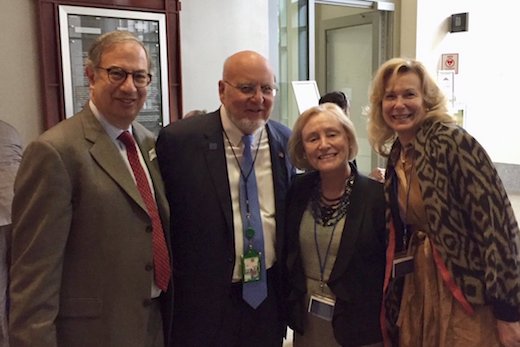Despite advances in controlling HIV transmission and infection, challenges remain in translating the science into programs, both in the United States and around the world, HIV/AIDS researchers said at a national Centers for AIDS Research conference held at Emory on Thursday, Nov. 8.
Major themes at the scientific symposium included HIV in the Southeast, vaccine/cure immunology and overlap with the opioid epidemic. Highlights included plenary talks from Anthony Fauci, director of the National Institute of Allergy and Infectious Diseases, Robert Redfield, director of the Centers for Disease Control and Prevention (CDC) and Ambassador Deborah Birx, director of the Office of the Global AIDS Coordinator in the President’s Emergency Program for AIDS Relief (PEPFAR).
The meeting included both dazzling immunotherapy and gene editing research, and calls for strengthening of public health infrastructure, so that the science does not leave communities behind. Emory’s Center for AIDS Research (CFAR) -- celebrating its 20th year of funding -- hosted the get-together of its peer centers from across the country at Rollins School of Public Health.
In the United States, the majority of new HIV infections (52 percent) are occurring in the Southeast, according to 2016 CDC statistics. Eugene McCray, director of HIV/AIDS prevention at the CDC, noted that in the Southeast, a higher number of new HIV infections (23 percent) occur in suburban and rural areas, compared with other areas of the country.
Several speakers said that the Southeast has higher income inequality, a legacy of racial discrimination, and health infrastructure limitations, which slow progress in fighting HIV/AIDS.
Wendy Armstrong, medical director of the Grady Ponce de Leon Center in Atlanta, offered “lessons from the front.” She and her team are treating more than 6,000 patients at the Ponce Center clinic – a 33 percent increase over the last 10 years. With flat federal funding, that means resources available per patient have declined, and hard choices emerge. In 2016, Armstrong and her colleagues started a “rapid entry” program, which aimed to accelerate access to HIV care, but it had to close temporarily because of demand, she said.
“It is dangerous to keep talking about the end of AIDS, when it leads to complacency and lack of understanding in our communities,” she noted.
She cited a text from a colleague working in the HIV inpatient service at Grady who had recently encountered the worst case of Kaposi’s sarcoma (an HIV/AIDS-associated viral skin cancer) he had seen, and warned that a shortage of HIV specialist providers was looming.
David Malebranche from Morehouse School of Medicine challenged the audience to view HIV/AIDS care like running a restaurant. If the service is disrespectful, don’t blame the customers for not coming back, he said.
“Science is wasted if we forget about the art of medicine,” Malebranche said.
Redfield emphasized how lessons from HIV also apply to the opioid epidemic, observing that “stigma is the enemy of public health.” The annual number of HIV infections in the United States was declining until a few years ago, when it appeared to hit a floor. Infectious disease outbreaks in rural areas, similar to a 2015 HIV outbreak in southern Indiana, are at risk of emerging as a result of injection drug use, Redfield said.
“Progress against the opioid crisis is critical to avoid losing gains in reducing HIV,” he said.
As one example, Hannah Cooper, a public health researcher at Rollins School of Public Health, reported her findings studying people from rural Kentucky who used injected drugs. She and her colleagues found an alarmingly high rate of sharing syringes and drug-related equipment, indicating a high risk for HIV infection. A syringe service program would be an optimal intervention, Cooper said, adding that “we have a window of opportunity to prevent an HIV outbreak.”
Fauci was optimistic while reviewing recent research on advances in controlling HIV. Antiretroviral drugs can effectively stop HIV transmission, and a variety of broadly neutralizing antibodies from patients can be harnessed as tools to control infection in others, he noted. “Next generation” clinical trials of HIV vaccines are underway in South Africa. These approaches, combined, have the potential to end the HIV epidemic, Fauci said. At the same time, clear geographic and demographic “hot spots” persist. In some parts of the Kwazulu Natal region of South Africa, a near majority of pregnant women are HIV-positive, according to a slide Fauci presented.
In a portion of the symposium devoted to preclinical research, Mirko Paiardini from Yerkes National Primate Research Center described an ongoing study probing whether immunotherapies, now used for cancer, could push virus-infected cells out of their “reservoir” hiding places. The scientific symposium also included a panel of research study participants and a lunchtime poster session.
In a closing talk, ambassador Birx noted that some countries in Africa have made considerable progress. In Namibia, 96 percent of people with HIV diagnoses are on antiretroviral therapy – more than estimates in many states in the United States.
“Policies matter, political will matters, and data matters,” she concluded. She challenged public health and HIV investigators in the Southern US to get timely data and to ask, do we have the right programs in the right places? She said that progress is possible utilizing the best science and tools, triangulating program data, performing qualitative data and community surveys to show our successes and failures and providing a map to change the course of the HIV pandemic.

